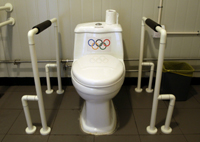Tennis titans and tinkling tills in a not-so-rural village
by Paul Myers
Article published on the 2008-08-07 Latest update 2008-08-08 08:29 TU
The Swiss has ruled the roost for the past four and a half years. But on 18 August the Spaniard Rafael Nadal will supplant him.
Federer is in Beijing because he’s after Olympic Gold. He’s won lots of other major titles and he’s keen to triumph here.
Victory could revivify his season after his defeats at Nadal's hands at the French Open and Wimbledon.
Federer has been abject in his appearances since that defeat on the lawns of south-west London while the Spaniard has been impressive going on to win another title in Toronto.
While the two titans of tennis prepare to take chunks out of each other yet again, other athletes are relaxing in the village before the white heat of competition begins on Saturday.
This village houses some 15,000 athletes from the 205 national Olympic associations worldwide. Olympic Babel would be more appropriate.
And it’s certainly not a village in the modern British sense of the word because there are shops open and they’re flourishing.
Myriad languages may be circulating but they can all communicate when it comes to buying.
And why not? For the general store (open 9am–11pm) offers athletes the chance to take care of life’s little banalities before their battles for supremacy begin.
They can stock up on those cutesy gifts for friends and family back home in Kazakhstan or Mauritania.
After all who could resist a set of commemorative Beijing Olympic pins for 999 yuan (about 100 euros)?
If that’s a bit out of the price range then a simple mug for 28 yuan?
That’s so much more within my budget that I nearly bought one. I didn’t as I’d probably have tried to have a cup of tea in it at the traditional Chinese tea house just along from the general store.
A notice outlined the available brews – oolong, green tea, black tea, jasmine and pu’er. A smiling woman – OK, let’s call her a tealady – came out and engaged me in conversation.
She told me that there’d be a performance - OK, let’s call it a tea dance – a bit later in the afternoon.
She advised the 4pm show as that was the best time for tea.
“That’s when the British usually have a cup,” I beamed.
I used to get a brew called tarry souchong from the tea section at Harrods, it was a smoky number and it was excellent. Problem was I found I was getting less and less time to savour it.
It’s not something for when you’re harried and that’s the state of mind in which I have been taking my tea these days.
I’m pretty sure the Chinese approach to tea is more ceremonial than my present bag thrust into a mug. If only I could buy the time to linger over the oolong.





